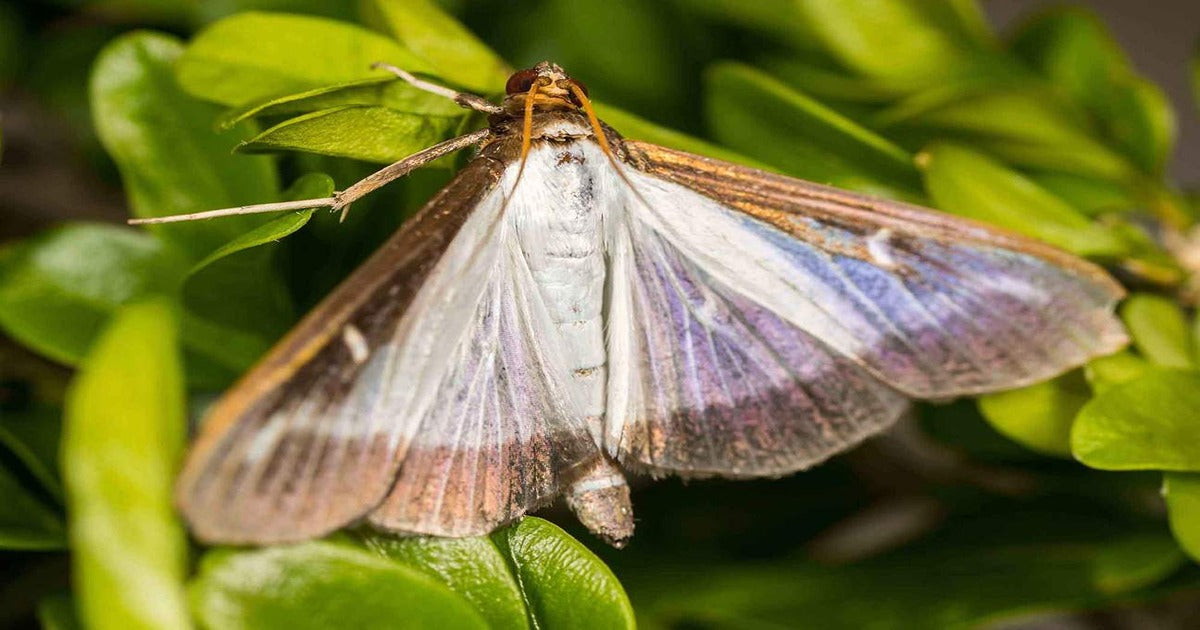
Dragonfli's Three-Step Strategy To Combat The Entire Box Tree Moth Life Cycle
Box Tree Moths overwinter as caterpillars that hide deep inside the Box Plant foliage. As temperatures warm, the caterpillars will pupate and transform into moths. The female moths will proceed to mate and begin laying eggs in little clusters on Box tree plants. These eggs will then hatch into the damaging caterpillars that devastate and kill Box plants and hedges.
Dragonfli are on hand to help, however, and can now provide natural solutions against all three stages of the Box Tree Moth life cycle!

Box Tree Caterpillars feed on Box plants and hedges and are capable of killing Buxus entirely if left untreated.
Stage 1: Catch Adult Box Tree Moths With Pheromone Traps To Reduce Egg Laying
The first step to take in combating Box Tree Moths is to set up your Box Tree Moth Pheromone Traps. These traps will catch male Box Tree Moths and prevent them from mating with females. The traps will also provide you with a valuable early warning of Box Tree Moth activity.
Our Box Tree Moth Pheromone Traps are the first key component in the three pronged attack against Box Tree Moth infestations.
Box Tree Moths have 2-3 generations a year, so it is good practice to keep your Box Tree Pheromone Traps active all spring and summer. Each pheromone lure lasts about six weeks, after which it should then be replaced. You can find replacement lures by clicking here.
Pheromone traps used solely will not catch enough Box Tree Moths to prevent entire infestations, so please be sure to also follow the next steps.

Box Tree Moths are identifiable with white coloured wings bordered by brown. They have a wingspan of roughly 4cm.
Stage 2: Use Trichogramma Parasitic Wasps To Kill Box Tree Moth Eggs
Once Box Tree Moths are observed, it won’t be long before egg laying takes place. These eggs can now be controlled, however, by tiny parasitic wasps contained in small sachets that are placed within Box tree plant foliage. The Trichogramma evanescens parasitic wasps that emerge from our Box Tree Moth Egg Killer Sachets will search the Box tree plants for Box Tree Moth eggs. Once located, the Box Tree Moth eggs are parasitised and killed. The eggs then, instead of producing Box Tree Caterpillars, release new Trichogramma wasps to locate and kill more Box Tree Moth eggs!

Our Box Tree Moth Egg Killer Sachets can be harnessed to kill Box Tree Moth eggs lain by the female Box Tree Moths that were able to mate.
The sachets will continue to release the Trichogramma wasps for up to 4 weeks. We suggest placing one sachet every 5 linear metres of Box hedging, or 1 sachet every 10 square metres. If you have large individual Box tree plants, one sachet can be applied to each plant.

Box Tree Moth eggs are often hidden, and quite difficult to spot with the human eye but don't worry our Trichogramma wasps will be able to find and kill them for you!
Stage 3: Apply Nematodes Directly Onto Box Tree Caterpillars
If Box Tree Caterpillars are observed on Box plants, apply our Box Tree Caterpillar Killer Nematodes directly onto the caterpillars. Only apply the nematodes if caterpillars are present. More than one application may be required, which is why two sachets of nematodes are included in Box Tree Caterpillar Killer. Apply the first sachet when Box Tree Caterpillars are identified, and apply the second sachet about a week later.

Simply spray our Box Tree Caterpillar Killer directly onto the caterpillars and the nematodes will enter the pest via a natural opening, before killing the caterpillars from inside.
Make sure unopened nematode sachets are stored in a fridge to keep them fresh, and avoid applying nematodes on bright, sunny days, as nematodes are U.V sensitive. The optimum conditions for applying nematodes are warm, overcast, humid days. Alternatively, simply apply the nematodes early, or late on in the day.

Box Tree Caterpillars can grow up to 30mm in length and are a greenish-yellow colour. They can be concealed within webbing spun around buxus plants.
Enjoy Renewed Box Plant Growth

These three natural solutions combine to provide a complete biological control of Box Tree Moths and protect your valuable Box Hedges and plants from this devastating pest.
If looking to provide your Box plants with a further aid to recovery, consider also applying our Soil Boost biostimulant granules.
Soil Boost acts as an organic slow release fertiliser, helping the Box plants achieve newly invigorated growth after stress and damage.
If you ever need any further advice on how to combat Box Tree Moths feel free to get in touch via email at sales@dragonfli.co.uk, via social media, or by giving us a call on 01376 563322, and we’d be happy to assist.
Comments (Responses)
Julian Ives
Hi Susie, thanks for getting in touch.
I’d advise that you set up your Box Tree Moth Pheromone Traps to continue to catch as many moths as you can throughout this month and into October as the traps will continue to operate effectively in spite of weather conditions. In this way you can hope to disrupt the life cycle of a proportion of the moths and prevent overwintering capacity for any caterpillars they may have otherwise produced.
With regards to nematode treatments you will still have success over the next couple of weeks if you’re able to apply them when temperatures are at their highest, as the days are remaining relatively mild thus far. The nematodes only need a couple of hours to infect the caterpillars and the humid, overcast conditions currently are favourable to nematode applications so I would certainly suggest to apply the nematodes now directly onto any caterpillars you spot. Again it is worth reiterating that it is critical to combat as many caterpillars as possible now to eliminate the opportunity for the pests to overwinter.
In terms of the Trichogramma wasps contained within our Box Tree Moth Egg Killer Sachets I would indeed say temperatures are now no longer suitable for the effective application of this product outdoors, purely as night time temperatures are likely to kill the Trichogramma.
For preparedness next year I would suggest you ensure your traps are set up with active pheromone lures from April. The initial catches in these traps will give you an idea of how likely a repeat infestation is and the potential severity of such infestation. You can then look at using the nematodes and trichogramma wasps again as temperatures warm up.
If you need any further information please let us know and we’ll be happy to advise further.
Kind regards, Julian Ives [Director, Dragonfli]
Mrs Claire Freemantle
I’m slightly confused as to which treatment I should use and when. I managed to remove many dozens of caterpillars by hand before significant damage was done. I understand that I would need to set up traps next spring but should I now install the parasitic wasp sachets as there will presumably be eggs that are both difficult to see and cannot be effectively removed by hand? Advice would be appreciated.
Susie
Hi I have a mild infestation of box moth caterpillars over a large garden of box topiary and have sprayed with nematodes. I’m just wondering, given the time of year, should I bother with moth traps and wasps for this season. If not, when do you suggest I start up those things next year. Many thanks. Susie
Julian Ives
Hi Kirsty, thanks for getting in touch.
I’m so glad to hear that our Box Tree Moth Trap is proving to be mightily effective for you.
Yes, we would recommend to drown the caught moths, empty the trap and then set it up again. You do not need to replace the trap and only need to replace the pheromone lure after it has been active for 6 weeks, such is the duration of this pheromone. Once the six weeks have elapsed dispose of the lure and replace it with your second lure.
With regards to now using the parasitic wasps contained within our Box Tree Moth Egg Killer Sachets, outside temperatures are dropping so the conditions are only borderline optimal for effective application. I would instead advise that, if you can identify the Box Tree Caterpillars, you remove them as best you can and spray them with out Box Tree Caterpillar Killer nematodes – ensuring the nematodes come into direct contact with the caterpillars.
Hope this all helps but if you need any further advice please feel free to get in touch again.
Kind regards, Julian Ives [Director, Dragonfli]







21 September, 2023
Julian Ives
Hi Claire, thanks for getting in touch.
I’m sorry for the trouble you are having with selecting the best treatment and I’ll be happy to help you navigate our range of controls to identify the most suitable.
That’s great you were able to manually remove so many of the caterpillars, I believe you’ve done a great service to your buxus plants there!
As I’ve stated in the previous comment I would suggest that you continue to use traps now to catch any active moths and reduce mating that could lead to future generations of caterpillars overwintering in your garden.
Unfortunately as I’ve also stated below it will now be too cold in the evenings for effective use of the Box Tree Moth Egg Killer Sachets to combat any freshly laid eggs. I would advise instead that you continue to pick off the caterpillars when you see them, or alternatively apply our Box Tree Caterpillar Killer nematodes directly onto the caterpillars to kill them. There are still a couple weeks of mild weather forecasted that could provide a final window to apply the nematodes to kill as many Box Tree Caterpillars as possible.
If you need any further assistance please just let us know.
Kind regards, Julian Ives [Director, Dragonfli]